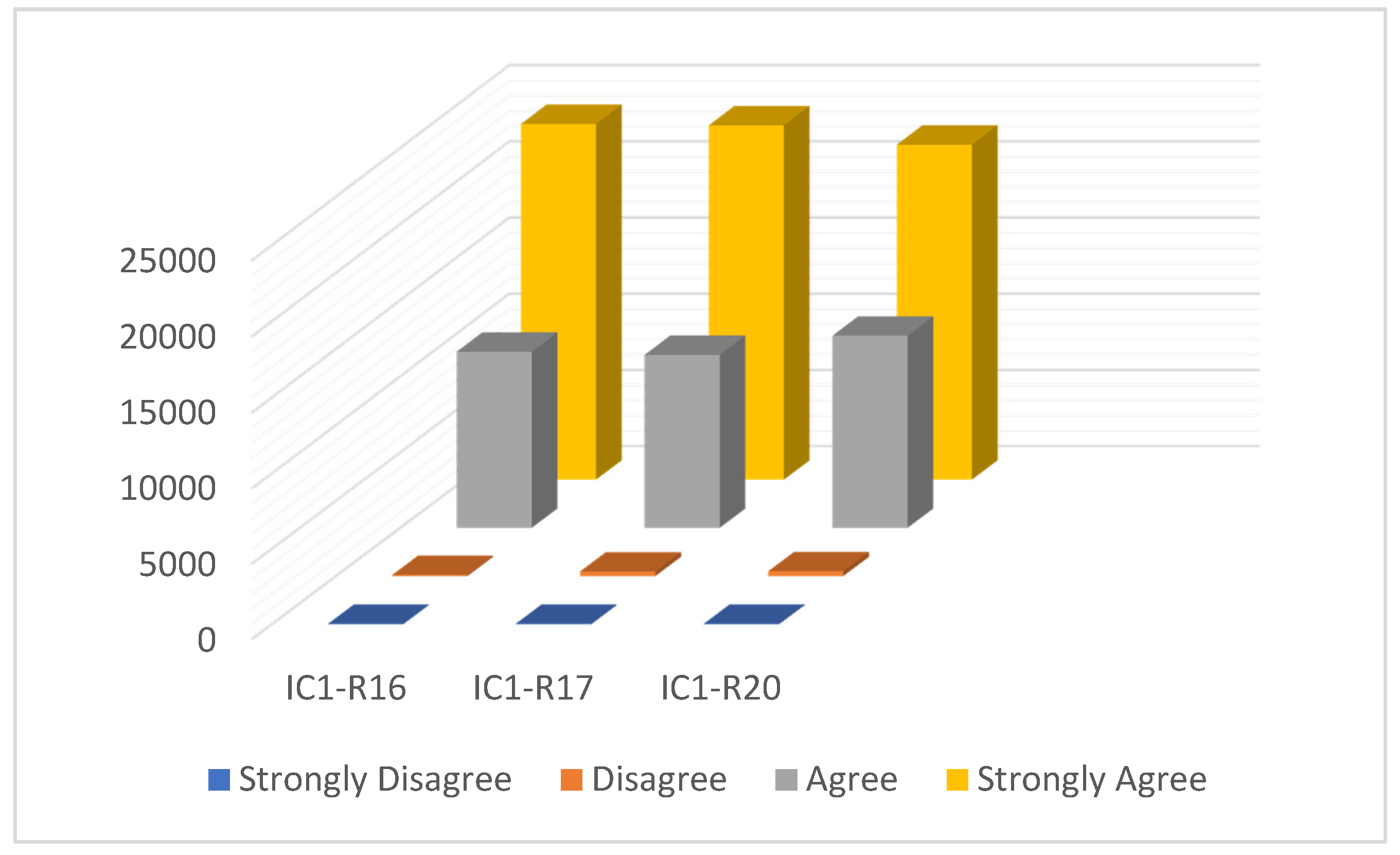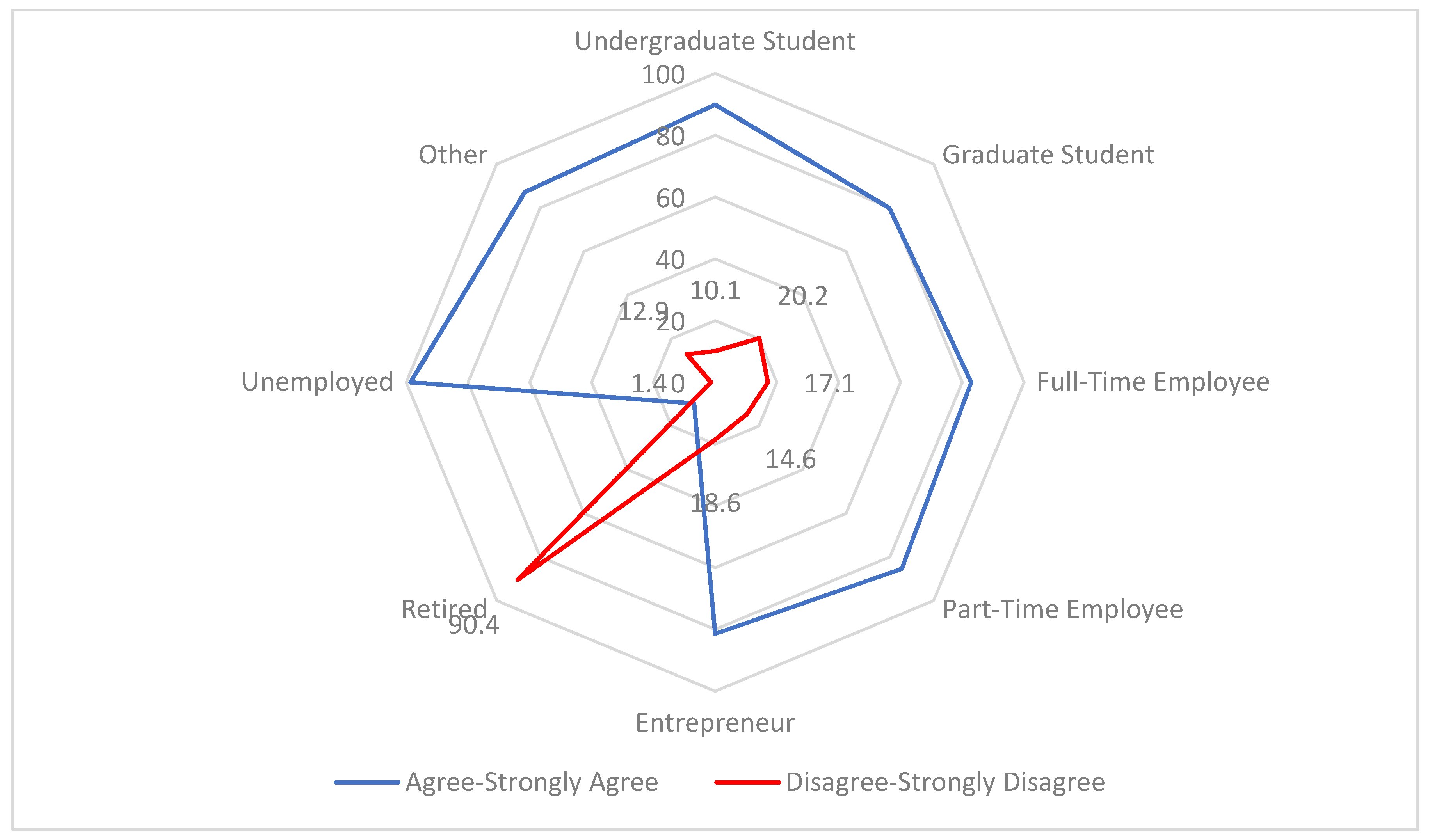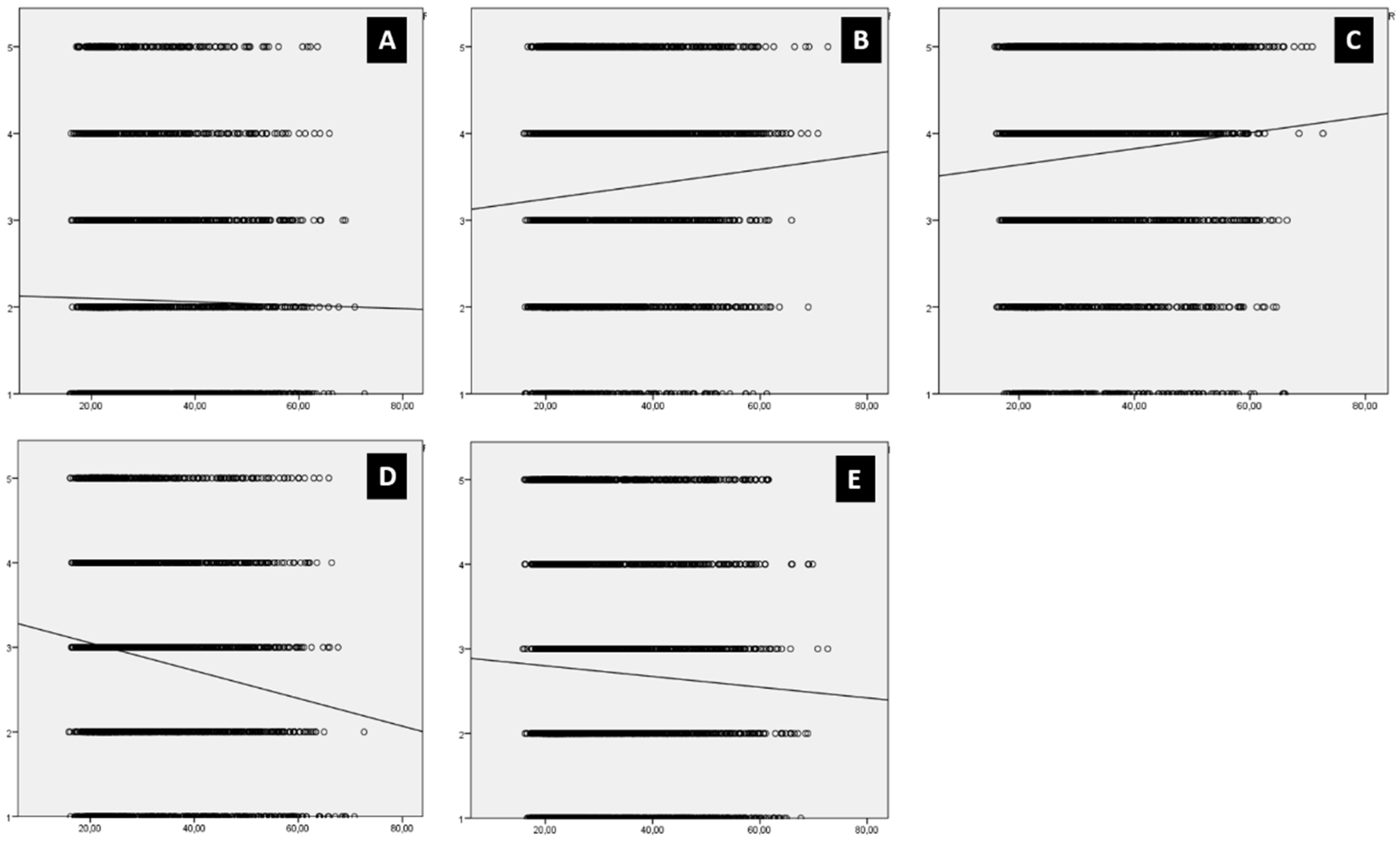Determining Factors in MOOCs Completion Rates: Application Test in Energy Sustainability Courses
Abstract
1. Introduction
2. Materials and Methods
2.1. Sample Preparation
2.2. Instruments
- IC1-R16: I think this course will help to satisfy the training needs that led me to enroll in it. [Personal/Academic and Training].
- IC1-R17: I believe that this course will help improve my professional development (current or future). [Professional Improvements].
- IC1-R20: I think this course will improve my academic training. [Academic and Training].
- FC1-R05: This course fulfilled the training needs that led me to enroll in it. [Personal/Academic and Training].
- FC1-R06: After having taken the course, I am convinced that this course will help improve my professional development. [Professional Improvements].
- FC1-R09: I think this course improved my academic background. [Academic and Training].
- FC1-R12: To which factors do I ascribe the successful completion of this course (in order of highest to lowest importance, with 1 being the most critical factor and 5 the least important factor)? [All factors].
- ○
- Response options: Personal factors, family factors, social factors, instructional design factors, and labor factors.
3. Results
Personal, Academic and Professional Expectations-Values
4. Discussion
Author Contributions
Funding
Conflicts of Interest
References
- Lambert, S.R. Do MOOCs contribute to student equity and social inclusion? A systematic review 2014–18. Comput. Educ. 2020, 145, 103693. [Google Scholar] [CrossRef]
- Deng, R.; Benckendorff, P.; Gannaway, D. Learner engagement in MOOCs: Scale development and validation. Br. J. Educ. Technol. 2020, 51, 245–262. [Google Scholar] [CrossRef]
- Dai, H.M.; Teo, T.; AnneRappa, N.; Huang, F. Explaining Chinese university students’ continuance learning intention in the MOOC setting: A modified expectation confirmation model perspective. Comput. Educ. 2020, 150, 103850. [Google Scholar] [CrossRef]
- Barak, M.; Watted, A.; Haick, H. Motivation to learn in massive open online courses: Examining aspects of language and social engagement. Comput. Educ. 2016, 94, 49–60. [Google Scholar] [CrossRef]
- Loizzo, J.; Ertmer, P.A.; Watson, W.R.; Watson, S.L. Adult MOOC learners as self-directed: Perceptions of motivation, success, and completion. Online Learn. 2017, 21, n2. [Google Scholar] [CrossRef]
- Littlejohn, A.; Hood, N.; Milligan, C.; Mustain, P. Learning in MOOCs: Motivations and self-regulated learning in MOOCs. Internet High. Educ. 2016, 29, 40–48. [Google Scholar] [CrossRef]
- Salmon, G.; Gregory, J.; Lokuge Dona, K.; Ross, B. Experiential online development for educators: The example of the C arpe D iem MOOC. Br. J. Educ. Technol. 2015, 46, 542–556. [Google Scholar] [CrossRef]
- Valdivia Vázquez, J.A.; Ramírez-Montoya, M.-S.; Valenzuela-González, J.R. Motivation and knowledge: Pre-Assessment and post-assessment of MOOC participants from an energy and sustainability project. Int. Rev. Res Open Distrib. Learn. 2018, 19, 116–132. [Google Scholar] [CrossRef]
- Guajardo-Leal, B.E.; Navarro-Corona, C.; Valenzuela-González, J.R. Systematic mapping study of academic engagement in MOOC. Int. Rev. Res. Open Distrib. Learn. 2019, 20. [Google Scholar] [CrossRef]
- Guajardo-Leal, B.E.; Valenzuela, J.R.; Scott, J. Student engagement as a predictor of xMOOC completion: An analysis from five courses on energy sustainability. Online Learn. 2019, 23, 105–123. [Google Scholar] [CrossRef]
- Branson, K.J. Academic Self-Efficacy and Massive Open Online Course (MOOC) Completion Rates: Do Academic Self-Efficacy and Adult Learner Characteristics Influence MOOC Outcomes? Ph.D. Thesis, San Diego State University, San Diego, CA, USA, 2017. [Google Scholar]
- Sun, Y.; Ni, L.; Zhao, Y.; Shen, X.L.; Wang, N. Understanding students’ engagement in MOOCs: An integration of self-determination theory and theory of relationship quality. Br. J. Educ. Technol. 2019, 50, 3156–3174. [Google Scholar] [CrossRef]
- Jansen, R.S.; Van Leeuwen, A.; Janssen, J.; Conijn, R.; Kester, L. Supporting learners’ self-regulated learning in Massive Open Online Courses. Comput. Educ. 2020, 146, 103771. [Google Scholar] [CrossRef]
- Cowan, S.; Sood, S.; Truby, H.; Dordevic, A.; Adamski, M.; Gibson, S. Inflaming Public Interest: A qualitative study of adult learners’ perceptions on nutrition and inflammation. Nutrients 2020, 12, 345. [Google Scholar] [CrossRef] [PubMed]
- Bajwa, A.; Bell, A.; Hemberg, E.; O’Reilly, U.M. Analyzing student code trajectories in an introductory programming MOOC. In Proceedings of the 2019 IEEE Learning With MOOCS (LWMOOCS), IEEE, Milwaukee, WI, USA, 23–25 October 2019; pp. 53–58. [Google Scholar] [CrossRef]
- Ferguson, R.; Clow, D. Examining engagement: Analysing learner subpopulations in massive open online courses (MOOCs). In Proceedings of the Fifth International Conference on Learning Analytics and Knowledge (LAK15), Poughkeepsie, NY, USA, 14–16 March 2015; pp. 51–58. [Google Scholar] [CrossRef]
- García-Martín, J.; García-Sánchez, J.N. The effectiveness of four instructional approaches used in a MOOC promoting personal skills for success in life. Rev. Psicodidáct. Engl. Ed. 2020, 25, 36–44. [Google Scholar] [CrossRef]
- Wen, Y.; Tian, Y.; Wen, B.; Zhou, Q.; Cai, G.; Liu, S. Consideration of the local correlation of learning behaviors to predict dropouts from MOOCs. Tsinghua Sci. Technol. 2019, 25, 336–347. [Google Scholar] [CrossRef]
- Tang, C.M.; Chaw, L. Driving high inclination to complete massive open online courses (Moocs): Motivation and engagement factors for learners. Electron. J. e-Learn. 2019, 17, 118–130. [Google Scholar]
- Xie, Z. Modelling the dropout patterns of MOOC learners. Tsinghua Sci. Technol. 2019, 25, 313–324. [Google Scholar] [CrossRef]
- Shukor, N.A.; Abdullah, Z. Using learning analytics to improve MOOC instructional design. Int. J. Emerg. Technol. Learn. iJET 2019, 14, 6–17. [Google Scholar] [CrossRef]
- Stathakarou, N.; Scully, M.L.; Kononowicz, A.A.; Henningsohn, L.; Zary, N.; McGrath, C. MOOC learners’ engagement with two variants of virtual patients: A randomised trial. Educ. Sci. 2018, 8, 44. [Google Scholar] [CrossRef]
- Borrás-Gené, O.; Martínez-Núñez, M.; Martín-Fernández, L. Enhancing fun through gamification to improve engagement in MOOC. Informatics 2019, 6, 28. [Google Scholar] [CrossRef]
- Cooharojananone, N.; Moolpun, O.; Pawong, P.; Dilokpabhapbhat, J.; Rimnong-ang, T.; Choosuwan, M.; Pongnumkul, S. A study of influences of social network awareness on MOOC learner behaviors: Case of Chulalongkorn University free MOOC. In Proceedings of the IEEE 10th International Conference on Awareness Science and Technology (iCAST), Morioka, Japan, 23–25 October 2019; pp. 1–6. [Google Scholar] [CrossRef]
- Sanz-Martínez, L.; Er, E.; Martínez-Monés, A.; Dimitriadis, Y.; Bote-Lorenzo, M.L. Creating collaborative groups in a MOOC: A homogeneous engagement grouping approach. Behav. Inf. Technol. 2019, 38, 1107–1121. [Google Scholar] [CrossRef]
- University of Michigan. Certificates Boost MOOC Completion Rates. US Fed News Service, Including US State News; University of Michigan: Washington, DC, USA, 2019. [Google Scholar]
- Gil-Jaurena, I.; Callejo-Gallego, J.; Agudo, Y. Evaluation of the UNED MOOCs implementation: Demographics, learners’ opinions and completion rates. Int. Rev. Res. Open Distrib. Learn. 2017, 18. [Google Scholar] [CrossRef]
- Formanek, M.; Buxner, S.; Impey, C.; Wenger, M. Relationship between learners’ motivation and course engagement in an astronomy massive open online course. Phys. Rev. Phys. Educ. Res. 2019, 15, 020140. [Google Scholar] [CrossRef]
- Hollebrands, K.F.; Lee, H.S. Effective design of massive open online courses for mathematics teachers to support their professional learning. ZDM 2020, 1–17. [Google Scholar] [CrossRef]
- Osuna-Acedo, S.; Marta-Lazo, C.; Frau-Meigs, D. From sMOOC to tMOOC, learning towards professional transference: ECO European Project. Comunicar 2018, 26, 105–114. [Google Scholar] [CrossRef]
- Kizilcec, R.F.; Piech, C.; Schneider, E. Deconstructing disengagement: Analyzing learner subpopulations in Masive Open Online Courses. In Proceedings of the 3rd International Conference on Learning Analytics and Knowledge (LAK13), Leuven, Belgium, 12–17 April 2013; p. 10. [Google Scholar]
- Romero-Rodríguez, L.M.; Ramírez-Montoya, M.S.; Valenzuela González, J.R. Gamification in MOOCs: Engagement application test in energy sustainability courses. IEEE Access 2019, 7, 32093–32101. [Google Scholar] [CrossRef]
- Beltrán Hernández de Galindo, M.J.; Romero-Rodríguez, L.M.; Ramírez-Montoya, M.S. Entrepreneurship competencies in energy sustainability MOOCs. J. Entrep. Emerg. Econ. 2019, 11, 598–616. [Google Scholar] [CrossRef]
- Romero-Rodríguez, L.M.; Ramírez-Montoya, M.S.; Valenzuela-González, J.R. Incidence of digital competences in the completion rates of MOOCs: Case study on energy sustainability courses. IEEE Trans. Educ. 2020. Pre-print. [Google Scholar] [CrossRef]
- Manzini, F.; Islas, J.; Martínez, M. Reduction of greenhouse gases using renewable energies in Mexico 2025. Int. J. Hydrogen Energy 2001, 26, 145–149. [Google Scholar] [CrossRef]
- Daniel, J. Making sense of MOOCs: Musings in a maze of myths, paradox and possibility. J. Interact. Media Educ. 2012, 3, 1–20. [Google Scholar] [CrossRef]
- Yousef, A.M.F.; Chatti, M.A.; Wosnitza, M.; Schroeder, U. A cluster analysis of MOOC stakeholder perspectives. RUSC 2015, 12, 74–90. [Google Scholar] [CrossRef]
- Gordillo, A.; López-Perna, S.; Barra, E. Effectiveness of MOOCs for teachers in safe ICT use training. Comunicar 2019, 27, 103–112. [Google Scholar] [CrossRef]
- Lotero-Echeveri, G.; Romero-Rodríguez, L.M.; Pérez-Rodríguez, M.A. Fact-checking vs. Fakenews: Confirmation journalism as a tool of media literacy against misinformation. Index Comun. 2018, 8, 295–316. [Google Scholar]
- Romero-Rodríguez, L.M.; De Casas Moreno, P.; Torres Toukoumidis, A. Stereotypes, themes and language in television´s gutter programming: TVE´s “Corazon” program. Alteridad Rev. Educ. 2015, 10, 31–43. [Google Scholar] [CrossRef]
- Vázquez-Cano, E.; León Urrutia, M.; Parra-González, M.E.; López-Meneses, E. Analysis of interpersonal competences in the use of ICT in the Spanish University Context. Sustainability 2020, 12, 476. [Google Scholar] [CrossRef]
- López-Meneses, E.; Vázquez-Cano, E.; Román, P. Analysis and implications of the impact of MOOC movement in the scientific community: JCR and Scopus (2010–2013). Comunicar 2015, 44, 73–80. [Google Scholar] [CrossRef]
- Benítez-Díaz, L.M.; Sevillano, M.L.; Vázquez-Cano, E. Effects on academic performance in secondary students according to the use of ICT. IJERI Int. J. Educ. Res. Innov. 2019, 12, 90–108. [Google Scholar]



| MOOC | n (e) | n (f) | CR |
|---|---|---|---|
| Energy conservation | 12,929 | 2019 | 15.616% |
| Distribution of electrical energy | 5549 | 639 | 11.515% |
| Smart Grid: Electrical networks of the future | 6608 | 821 | 12.424% |
| Smart Grid: Technical fundamentals | 5498 | 743 | 13.514% |
| Electric power transmission | 5961 | 1074 | 18.017% |
| Conventional, clean energy and its technology | 18,693 | 2770 | 14.818% |
| Electric power: Concepts and principles | 15,978 | 1807 | 11.309% |
| Energy: Past, present, and future | 13,224 | 2106 | 15.925% |
| Carbon markets | 6710 | 910 | 13.561% |
| Energy markets | 10,255 | 846 | 8.249% |
| The new electricity industry in Mexico | 8975 | 1224 | 13.637% |
| Energy reform and its opportunities | 12,744 | 1928 | 15.128% |
| TOTAL | 123,124 | 16,887 | 13.715% |
| Factors | Likert Average (0–4) | k |
|---|---|---|
| Personal | 3.5 | 0.80 |
| Family | 4.25 | 0.75 |
| Academic and Training | 4.85 | 0.90 |
| Professional Improvements | 4.5 | 0.90 |
| Entrepreneurship | 2.85 | 0.35 |
| Work Opportunities | 3 | 0.65 |
| Labor Improvements | 4.0 | 0.80 |
| Social Concerns | 3.75 | 0.80 |
| Instructional Design | 4.25 | 0.85 |
| Factor | Gender | n | Mean | SD | SEM |
|---|---|---|---|---|---|
| Personal | M | 2167 | 2.09 | 1.308 | 0.028 |
| F | 1067 | 2.07 | 1.258 | 0.039 | |
| Familiar | M | 2221 | 3.32 | 1.259 | 0.027 |
| F | 1101 | 3.34 | 1.270 | 0.038 | |
| Social | M | 2369 | 3.71 | 1.298 | 0.027 |
| F | 1162 | 3.80 | 1.279 | 0.038 | |
| Instructional Design | M | 2334 | 2.87 | 1.242 | 0.026 |
| F | 1152 | 2.84 | 1.220 | 0.036 | |
| Labor | M | 2631 | 2.74 | 1.436 | 0.028 |
| F | 1289 | 2.69 | 1.430 | 0.040 |
| Levene’s Test for Equality of Variances | T-Test for Equality of Means | |||||
|---|---|---|---|---|---|---|
| F | Sig. | t | df | Sig. (2-tailed) | ||
| Personal | EVA | 4.403 | 0.036 | 0.387 | 3232 | 0.699 |
| EVNA | 0.393 | 2197.224 | 0.695 | |||
| Familiar | EVA | 0.073 | 0.787 | −0.285 | 3320 | 0.776 |
| EVNA | −0.284 | 2177.355 | 0.777 | |||
| Social | EVA | 3.154 | 0.076 | −1.936 | 3529 | 0.053 |
| EVNA | −1.945 | 2337.126 | 0.052 | |||
| Instructional Design | EVA | 1.578 | 0.209 | 0.624 | 3484 | 0.533 |
| EVNA | 0.628 | 2328.886 | 0.530 | |||
| Labor | EVA | 0.044 | 0.834 | 1.018 | 3918 | 0.309 |
| EVNA | 1.019 | 2567.240 | 0.308 | |||
© 2020 by the authors. Licensee MDPI, Basel, Switzerland. This article is an open access article distributed under the terms and conditions of the Creative Commons Attribution (CC BY) license (http://creativecommons.org/licenses/by/4.0/).
Share and Cite
Romero-Rodríguez, L.M.; Ramírez-Montoya, M.S.; Aguaded, I. Determining Factors in MOOCs Completion Rates: Application Test in Energy Sustainability Courses. Sustainability 2020, 12, 2893. https://doi.org/10.3390/su12072893
Romero-Rodríguez LM, Ramírez-Montoya MS, Aguaded I. Determining Factors in MOOCs Completion Rates: Application Test in Energy Sustainability Courses. Sustainability. 2020; 12(7):2893. https://doi.org/10.3390/su12072893
Chicago/Turabian StyleRomero-Rodríguez, Luis M., María Soledad Ramírez-Montoya, and Ignacio Aguaded. 2020. "Determining Factors in MOOCs Completion Rates: Application Test in Energy Sustainability Courses" Sustainability 12, no. 7: 2893. https://doi.org/10.3390/su12072893
APA StyleRomero-Rodríguez, L. M., Ramírez-Montoya, M. S., & Aguaded, I. (2020). Determining Factors in MOOCs Completion Rates: Application Test in Energy Sustainability Courses. Sustainability, 12(7), 2893. https://doi.org/10.3390/su12072893







